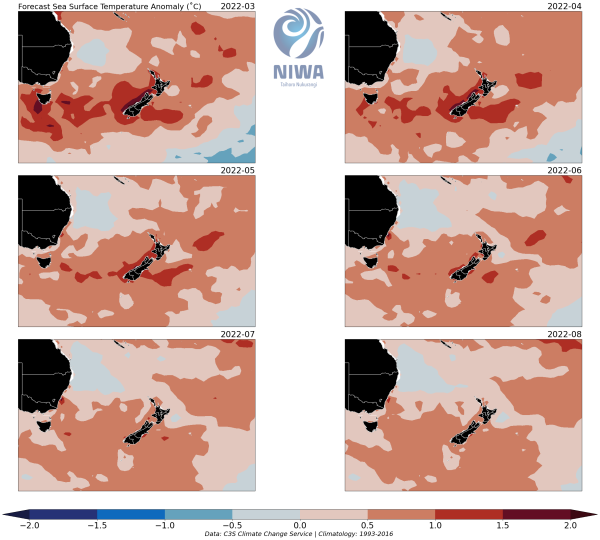Forecasting sea surface temperatures several months in advance is challenging. To give us insights into what might happen around Aotearoa New Zealand in the months to come, NIWA scientists have combined predictions from eight different climate models from institutes around the world.
Amid a changing climate, global sea surface temperatures are increasing. This will be associated with more frequent and intense marine heatwave events (which are defined as being an extended period of extremely warm ocean temperatures that can extend up to thousands of kilometres).
NIWA is drawing upon forecast simulations issued by the Copernicus Climate Change Service (C3S, https://climate.copernicus.eu/). Those simulations extend six months into the future, but predictions made further into the future tend to be less reliable than near-term forecasts. For example, forecasts made in June for July may prove to be substantially different to those first made in January.
NIWA will be issuing new forecasts around the 20th of each month. We present the results as forecasts of month-average temperature anomalies based on the difference between month average forecast temperature and corresponding averages derived from an analysis of historical observations (satellite-sensed sea-surface temperature, ARGO floats, ship-board observations etc.), spanning period (1993-2016) and month average observations of sea-surface temperatures (from satellite sensors and in-situ observations). Positive differences imply the month average temperatures exceed the corresponding historical average.
NIWA provides these forecasts in the hope that readers will find them interesting. We welcome any feedback, and are particularly interested in knowing more about:
- What geographic areas are you especially interested in?
- How are you using the forecasts?
- Could they be presented in a manner which would make them more useful to you?
- Do you hold historical sea-surface temperature for any region that could assist with our ongoing efforts to develop methods that enable us to downscale forecasts of offshore temperatures into inshore regions?
Forecast Coromandel Town SST anomalies (˚C) over the next 6 months:
| Month | 25th percentile | 50th percentile | 75th percentile |
| Mar | 1.31 | 1.33 | 1.43 |
| Apr | 1.12 | 1.13 | 1.52 |
| May | 0.74 | 0.96 | 1.4 |
| Jun | 0.55 | 0.79 | 1.23 |
| Jul | 0.45 | 0.64 | 1.11 |
| Aug | 0.33 | 0.49 | 0.93 |
Forecast Golden Bay SST anomalies (˚C) over the next 6 months:
| Month | 25th percentile | 50th percentile | 75th percentile |
| Mar | 1.16 | 1.51 | 1.85 |
| Apr | 1.23 | 1.43 | 1.63 |
| May | 1.24 | 1.29 | 1.35 |
| Jun | 0.98 | 1 | 1.02 |
| Jul | 0.8 | 0.82 | 0.85 |
| Aug | 0.63 | 0.66 | 0.68 |
Forecast Opotiki SST anomalies (˚C) over the next 6 months:
| Month | 25th percentile | 50th percentile | 75th percentile |
| Mar | 1.12 | 1.12 | 1.12 |
| Apr | 0.83 | 0.83 | 0.83 |
| May | 0.51 | 0.51 | 0.51 |
| Jun | 0.26 | 0.26 | 0.26 |
| Jul | 0.22 | 0.22 | 0.22 |
| Aug | 0.17 | 0.17 | 0.17 |
Forecast Pelorus Sound SST anomalies (˚C) over the next 6 months:
| Month | 25th percentile | 50th percentile | 75th percentile |
| Mar | 0.69 | 0.91 | 1.13 |
| Apr | 0.9 | 1.21 | 1.52 |
| May | 0.87 | 1.08 | 1.3 |
| Jun | 0.76 | 0.88 | 1 |
| Jul | 0.68 | 0.75 | 0.83 |
| Aug | 0.59 | 0.64 | 0.68 |
Disclaimer: The forecasts offered in this page draw upon modified Copernicus Climate Change Service Information [2022](C3S, https://climate.Copernicus.eu). There is inherent uncertainty in forecasting sea surface temperature and neither NIWA nor the licensors of the C3S products (being the European Union represented by the European Centre for Medium-Range Weather Forecasts) make any representations or warranties as to the information and figures on this page. Neither NIWA nor the licensor of the Copernicus products accept any liability for any loss or damage incurred by anyone from use or reliance on the information or figures.
This work is funded through NIWA’s Strategic Science Investment Fund from the Ministry for Business, Innovation and Employment.

